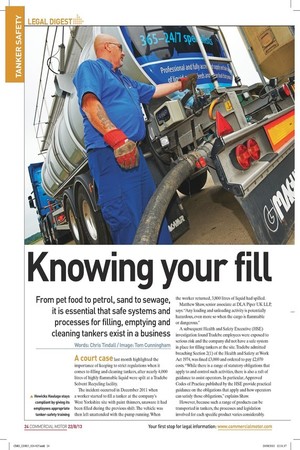Knowing your fill
Page 18

Page 19

If you've noticed an error in this article please click here to report it so we can fix it.
From pet food to petrol, sand to sewage, it is essential that safe systems and processes for filling, emptying and cleaning tankers exist in a business
A court case last month highlighted the importance of keeping to strict regulations when it comes to filling and cleaning tankers, after nearly 4,000 litres of highly flammable liquid were spilt at a Tradebe Solvent Recycling facility. The incident occurred in December 2011 when a worker started to fill a tanker at the company's West Yorkshire site with paint thinners, unaware it had been filled during the previous shift. The vehicle was then left unattended with the pump running. When
the worker returned, 3,800 litres of liquid had spilled.
Matthew Shaw, senior associate at DLA Piper UK LLP, says: "Any loading and unloading activity is potentially hazardous, even more so when the cargo is flammable or dangerous."
A subsequent Health and Safety Executive (HSE) investigation found Tradebe employees were exposed to serious risk and the company did not have a safe system in place for filling tankers at the site. Tradebe admitted breaching Section 2(1) of the Health and Safety at Work Act 1974, was fined £3,000 and ordered to pay £2,070 costs. "While there is a range of statutory obligations that apply to and control such activities, there is also a raft of guidance to assist operators. In particular, Approved Codes of Practice published by the HSE provide practical guidance on the obligations that apply and how operators can satisfy those obligations," explains Shaw.
However, because such a range of products can be transported in tankers, the processes and legislation involved for each specific product varies considerably.
Therefore, hauliers must assess all potential risks arising from their operation and take steps to remove or reduce those risks. Where petrol is being delivered, for example, operators must ensure there are shut-off valves in place in case of a spillage or emergency. Furthermore, all on-board pumping equipment must be fit for purpose and properly maintained, and all risks of fire and explosion must be eliminated or reduced as far as possible.
Shaw continues: "All road tanker operators, regardless of what they're carrying, must ensure their drivers are trained in [what to do] in the event of a spillage, and address any risks arising from working at height during any loading or unloading."
Safe systems
Risk assessments are critical to the process of safe filling and emptying of any product in tankers, and provide crucial evidence that safe systems exist and are being regulated.
Andrew Banks, a partner at Stone King Sewell solicitors, says: "Ensure a risk assessment has been done in relation to the relevant task and that there is a safe system of work in place. If in doubt, contact a health and safety consultant to advise on a safe system. Then train staff in those procedures and revisit the training annually. Document everything from risk assessments to training records."
Each risk assessment would need to be product-specific. "For example, transporting a product that gives off noxious fumes will have different safe systems of work when handling than, say, grain," adds Banks.
Besides the clear health and safety risks involved in tanker-related operations, hauliers who fail to follow the strict guidelines are liable to pay heavy fines and could face imprisonment.
"The maximum fine under the Health and Safety at Work Act 1974 is unlimited," says Banks. "Directors, senior managers and individuals can also be imprisoned for up to two years." HSE inspector Neil Casey points out that hauliers who fail to introduce robust safety procedures for filling
tankers should expect to be punished. "Companies whose businesses rely on the handling of hazardous substances with the potential to cause serious injuries, and even death, cannot afford to be complacent and should have adequate systems to control the risks that they generate," he explains. Although specific training is not set out in the health and safety regulations, it is best to ensure employees are safe and aren't posing any risks to others — and if that keeps you out of prison, then all the better. •
AI:11iiIIE1 [I]N
The processes and systems for dealing with products carried in a tanker differ from one to another, and are subject to many different regulations. However, among all of these, it is worth noting that ADR regulations for the carriage of dangerous goods include a section on the provisions for loading, unloading, and handling of all products classed as dangerous.
It also specifies how vehicles and containers must be cleaned following spillages and when dangerous loads are being replaced by a different product.
Anton Balkitis, a partner at Rothera Dowson, says: "Breaches generally are prosecuted by the HSE. The decision whether to prosecute should take account of the evidential stage and the relevant public interest factors. Health and safety law gives the courts considerable scope to punish offenders and to deter others, including imprisonment for some offences. Unlimited fines may be imposed by higher courts."









































